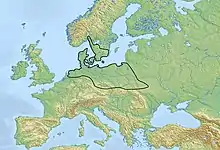 | |
| Geographical range | Europe |
|---|---|
| Period | Neolithic, Chalcolithic |
| Dates | c. 4300 BCE – 2800 BCE |
| Preceded by | |
| Followed by | |
The Funnel(-neck-)beaker culture, in short TRB or TBK (German: Trichter(-rand-)becherkultur, Dutch: Trechterbekercultuur; Danish: Tragtbægerkultur; c. 4300–2800 BCE), was an archaeological culture in north-central Europe. It developed as a technological merger of local neolithic and mesolithic techno-complexes between the lower Elbe and middle Vistula rivers. These predecessors were the (Danubian) Lengyel-influenced Stroke-ornamented ware culture (STK) groups/Late Lengyel and Baden-Boleráz in the southeast, Rössen groups in the southwest and the Ertebølle-Ellerbek groups in the north. The TRB introduced farming and husbandry as major food sources to the pottery-using hunter-gatherers north of this line.
The TRB techno-complex is divided into a northern group including modern northern Germany and southern Scandinavia (TRB-N, roughly the area that previously belonged to the Ertebølle-Ellerbek complex), a western group in the Netherlands between the Zuiderzee and lower Elbe that originated in the Swifterbant culture, an eastern group centered on the Vistula catchment, roughly ranging from Oder to Bug, and south-central groups (TRB-MES, Altmark) around the middle and upper Elbe and Saale. Especially in the southern and eastern groups, local sequences of variants emerged. In the late 4th millennium BCE, the Globular Amphora culture (GAC) replaced most of the eastern and subsequently also the southern TRB groups, reducing the TRB area to modern northern Germany and southern Scandinavia.
The younger TRB in these areas was superseded by the Single Grave culture (EGK) at about 2800 BCE. The north-central European megaliths were built primarily during the TRB era.
Nomenclature
The Funnelbeaker culture is named for its characteristic ceramics, beakers and amphorae with funnel-shaped tops, which were found in dolmen burials.
History
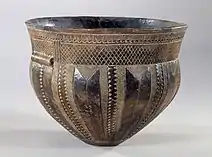
The Funnelbeaker culture emerged in northern modern-day Germany c. 4100 BCE.[1] Archaeological evidence strongly suggests that it originated through a migration of colonists from the Michelsberg culture of Central Europe.[1][2] The Michelsberg culture is archaeologically and genetically strongly differentiated from the preceding post-Linear Pottery cultures of Central Europe, being distinguished by increased levels of hunter-gatherer ancestry.[3] Its people were probably descended from farmers migrating into Central Europe out of Iberia and modern-day France, who in turn were descended from farmers of the Cardial Ware cultures who had migrated westwards from the Balkans along the Mediterranean coast.[4] Connections between the Funnelbeakers and these farmers of the Atlantic coast is supported by genetic evidence.[5]
After its establishment, the Funnelbeaker culture rapidly spread into southern Scandinavia and Poland, in what appears to have been a well-organized colonizing venture.[1][6] In southern Scandinavia it replaced the Ertebølle culture, which had maintained a Mesolithic lifestyle for about 1500 years after farming arrived in Central Europe.[7] The emergence of the Neolithic British Isles through maritime colonization by Michelsberg-related groups occurred almost at the same time as the expansion of the Funnelbeaker culture into Scandinavia, suggesting that these events may be connected.[8] Although they were largely of Early European Farmer (EEF) descent, people of the Funnelbeaker culture had a relatively high amount of hunter-gatherer admixture, particularly in Scandinavia, suggesting that hunter-gatherer populations were partially incorporated into it during its expansion into this region.[7] People of the Funnelbeaker culture often had between 30% and 50% hunter-gatherer ancestry depending on the region.
During later phases of the Neolithic, the Funnelbeaker culture re-expanded out of Scandinavia southwards into Central Europe, establishing several regional varieties.[6] This expansion appears to have been accompanied by significant human migration.[9] The southward expansion of the Funnelbeaker culture was accompanied by a substantial increase in hunter-gatherer lineages in Central Europe.[7] The Funnelbeaker communities in Central Europe which emerged were probably quite genetically and ethnically mixed, and archaeological evidence suggests that they were relatively violent.[10]
From the middle of the 4th millennium BCE, the Funnelbeaker culture was gradually replaced by the Globular Amphora culture on its southeastern fringes, and began to decline in Scandinavia.[13]
In the early 3rd millennium BCE, the Corded Ware culture appeared in Northern Europe. Its peoples were of marked steppe-related ancestry and traced their origins in cultures further east. This period is distinguished by the construction of numerous defensive palisades in Funnelbeaker territory, which may be a sign of violent conflict between the Funnelbeakers, Corded Ware, and Pitted Ware.[13] By 2650 BCE, the Funnelbeaker culture had been replaced by the Corded Ware culture.[6] Genetic studies suggest that Funnelbeaker women were incorporated into the Corded Ware culture through intermixing with incoming Corded Ware males, and that people of the Corded Ware culture continued to use Funnelbeaker megaliths as burial grounds.[14] Subsequent cultures of Late Neolithic, Bronze Age, and Iron Age Central Europe display strong maternal genetic affinity with the Funnelbeaker culture.[15]
Distribution
The TRB ranges from the Elbe catchment in Germany and Bohemia with a western extension into the Netherlands, to southern Scandinavia (Denmark up to Uppland in Sweden and the Oslofjord in Norway) in the north, and to the Vistula catchment in Poland and the area between Dnister and Western Bug headwaters in Ukraine in the east.
Variants of the Funnelbeaker culture in or near the Elbe catchment area include the Tiefstich pottery group in northern Germany as well as the cultures of the Baalberge group (TRB-MES II and III; MES = Mittelelbe-Saale), the Salzmünde and Walternienburg and Bernburg (all TRB-MES IV) whose centres were in Saxony-Anhalt.
Characteristics
Settlements
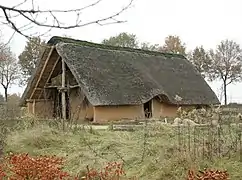
With the exception of some inland settlements such as the Alvastra pile-dwelling, the settlements are located near those of the previous Ertebølle culture on the coast. It was characterised by single-family daubed houses c. 12 m x 6 m.
In Olszanica 5000 BCE a longhouse was constructed with 2.2 m wide doors, presumably for wagon entry. This building was 40 m long with 3 doors.[16]
Economy
The Funnelbeaker culture was dominated by animal husbandry of sheep, cattle, pigs and goats, but there was also hunting and fishing. Primitive wheat and barley was grown on small patches that were fast depleted, due to which the population frequently moved small distances. There was also mining (in the Malmö region) and collection of flintstone (Świętokrzyskie Mountains), which was traded into regions lacking the stone, such as the Scandinavian hinterland. The culture used copper from Silesia, especially daggers and axes.
Technology
The Funnelbeaker Culture preserves the oldest dated evidence of wheeled vehicles in middle Europe.[17] One example is the engraving on a ceramic tureen from Bronocice in Poland on the northern edge of the Beskidy Mountains (northern Carpathian ring), which is indirectly dated to the time span from 3636 to 3373 BCE and is the oldest evidence for covered carriages in Central Europe.[18] They were drawn by cattle, presumably oxen whose remains were found with the pot. Today it is housed in the Archaeological Museum of Cracow (Muzeum Archeologiczne w Krakowie), Poland.
At Flintbek in northern Germany cart tracks dating from c. 3400 BCE were discovered underneath a megalithic long barrow. This is the earliest known direct evidence for wheeled vehicles in the world (i.e. not models or images).[19][20][21][22]
 The Bronocice Pot, Poland, c. 3500-3350 BCE.[23]
The Bronocice Pot, Poland, c. 3500-3350 BCE.[23] Wheeled vehicle representation
Wheeled vehicle representation
 Copper axe from Lüstringen, Germany, c. 4000 BCE
Copper axe from Lüstringen, Germany, c. 4000 BCE
Graves

Houses were centered on a monumental grave, a symbol of social cohesion. Burial practices were varied, depending on region and changed over time. Inhumation seems to have been the rule.
The oldest graves consisted of wooden chambered cairns inside long barrows, but were later made in the form of passage graves and dolmens. Originally, the structures were probably covered with a mound of earth and the entrance was blocked by a stone.
The Funnelbeaker culture marks the appearance of megalithic tombs at the coasts of the Baltic and of the North sea, an example of which are the Sieben Steinhäuser in northern Germany. The megalithic structures of Ireland, France and Portugal are somewhat older and have been connected to earlier archeological cultures of those areas. At graves, the people sacrificed ceramic vessels that contained food along with amber jewelry and flint-axes.
Religion
Flint-axes and vessels were also deposited in streams and lakes near the farmlands, and virtually all of Sweden's 10,000 flint axes that have been found from this culture were probably sacrificed in water. They also constructed large cult centres surrounded by pales, earthworks and moats. The largest one is found at Sarup on Fyn. It comprises 85,000 m2 and is estimated to have taken 8000 workdays. Another cult centre at Stävie near Lund comprises 30,000 m2.
Ethnicity
In the context of the Kurgan hypothesis (or steppe hypothesis), the culture is seen as non-Indo-European, representing a culture of Neolithic origin, as opposed to the Indo-European-language-speaking peoples (see Yamna culture) who later intruded from the east.[25]
Marija Gimbutas postulated that the political relationship between the aboriginal and intrusive cultures resulted in quick and smooth cultural morphosis into the Corded Ware culture.[26]
In the past, a number of other archaeologists proposed that the Corded Ware culture was a purely local development of the Funnelbeaker culture,[27] but genetic evidence has since demonstrated that this was not the case.[28]
Gallery
 Pottery, Denmark
Pottery, Denmark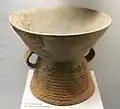 Pottery, Germany
Pottery, Germany Pottery, Germany
Pottery, Germany Pottery, stone axe, copper necklace
Pottery, stone axe, copper necklace Gold armring, Germany, c.3500 BCE
Gold armring, Germany, c.3500 BCE Copper lunula from Lüstringen, Germany, c. 4000 BCE
Copper lunula from Lüstringen, Germany, c. 4000 BCE Amber necklaces, Denmark.[29]
Amber necklaces, Denmark.[29] Pottery, Netherlands
Pottery, Netherlands Various artefacts, Germany
Various artefacts, Germany Ceramic cup, Germany
Ceramic cup, Germany Stone double-axe, Germany
Stone double-axe, Germany_6404.jpg.webp) Double-axe made from porphyry, Sweden
Double-axe made from porphyry, Sweden Pottery, Poland
Pottery, Poland Burial with poppies, Poland. Reconstruction.
Burial with poppies, Poland. Reconstruction. Excavated long barrow, Poland
Excavated long barrow, Poland Dolmen in Harhoog
Dolmen in Harhoog Round dolmen in Gribskov
Round dolmen in Gribskov Dolmen in North Zealand
Dolmen in North Zealand Oval or Long dolmen near Korsør
Oval or Long dolmen near Korsør Passage grave at Hulehøj, Bogø
Passage grave at Hulehøj, Bogø Klekkende Høj, interior
Klekkende Høj, interior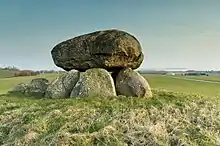 Dolmen in Mols, Denmark
Dolmen in Mols, Denmark Dolmen at Borger in Netherlands
Dolmen at Borger in Netherlands Tustrup jaettestue passage grave in Denmark
Tustrup jaettestue passage grave in Denmark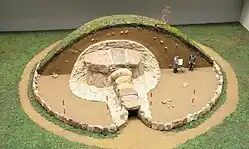 Model of the Denghoog passage grave in northern Germany
Model of the Denghoog passage grave in northern Germany Denghoog passage grave interior
Denghoog passage grave interior Long barrow grave model
Long barrow grave model Model of a Funnelbeaker culture house, Germany. Bomann-Museum
Model of a Funnelbeaker culture house, Germany. Bomann-Museum House reconstruction, Poland
House reconstruction, Poland House model, Poland, c. 3500 BC
House model, Poland, c. 3500 BC
Genetics
All genetic finds in the following are assigned to the Funnelbeaker (TrB) culture.
Malmström et al. 2009 examined 3 skeletons from Gökhem, Sweden which belonged to the maternal haplogroups H, J and T.[30]
Skoglund et al. 2012 examined another skeleton from Gökhem, Sweden. He was found to be a carrier of the maternal haplogroup H.[31] He was mostly genetically similar to modern Southern Europeans, while people of the Pitted Ware culture and other hunter-gatherers examined were found to be most genetically similar to modern Northern Europeans.[32]
Brandt et al. 2013 found that the Funnelbeaker culture of Scandinavia had a higher amount of hunter-gatherer maternal lineages than other cultures of Middle Neolithic Europe. They also found that the emergence of the Bernburg culture, a late variant of the Funnelbeaker culture in Central Europe, was accompanied by a genetic shift towards the population of Northern Europe, which was detected by significantly increased amount of hunter-gatherer lineages.[7]
Skoglund et al. 2014 again examined 3 skeletons from Gökhem, Sweden c. 5050-4750 BCE. The 3 samples belonged to the maternal haplogroups H1c, K1e and H24.[33] The study found hunter-gatherer admixture among the Funnelbeakers, but no evidence of Funnebeaker admixture among the Pitted Ware.[34]
Malmström et al. 2015 examined 9 skeletons from Resmo, Sweden and Gökhem, Sweden c. 3300-2600 BCE. The 8 samples of mtDNA extracted belonged to various subtypes of maternal haplogroup J, H/R, N, K and T.[35] The examined Funnelbeakers were closely related to Central European farmers, and different from people of the contemporary Pitted Ware culture.[36] The striking diversity of the maternal lineages suggested that maternal kinship was of little importance in Funnelbeaker society.[37] The evidence suggested that the Neolithization of Scandinavia was accompanied by significant human migration.[38]
Haak et al. 2015 analysed 3 skeletons of the Baalberge group of the Funnelbeaker culture. Two samples belonged to Y-haplogroup I and R1b1a, while the 3 samples of mtDNA belonged to haplogroup H1e1a, HV and T2e1. A male of the Salzmünde/Bernburg groups of the Funnelbeaker culture buried in Esperstedt, c. 3360-3086 BCE carried the Y-haplogroup I2a1b1a1 and the maternal haplogroup T2b.[39][40]
Lipson et al. 2017 examined 3 skeletons ascribed to the Salzmünde group of the Funnelbeaker culture. The 2 samples belonged to Y-haplogroup G2a2a1 and IJK, while the 3 samples of mtDNA extracted belonged to haplogroup H2 (2 samples) and U3a1.[41][42]
Mittnik et al. 2018 examined an early Funnelbeaker female skeleton from Kvärlöv, Sweden ca. 3945–3647 BCE. She carried maternal haplogroup T2b.[43] She was closely related to people of the Linear Pottery culture, but with increased level of hunter-gatherer admixture, which is comparable to other Middle Neolithic and Chalcolithic farmers of Europe. Genetic continuity with later Funnelbeaker samples was detected. Her hunter-gatherer admixture appeared to have been derived from a Western Hunter-Gatherer (WHG) or Baltic Hunter-Gatherer source rather than a Scandinavian Hunter-Gatherer (SHG) source.[44] Slight traces of Funnelbeaker ancestry was detected among the Pitted Ware culture (PWC).[45]
Sánchez-Quinto et al. 2019 examined 9 skeletons from a megalith in Ansarve on the island of Gotland, Sweden c. 3500-2580 BCE. The 4 samples Y-haplogroups I2a1b1a1 (3 samples) and I2a1b, while the 9 samples of mtDNA belonged to the maternal haplogroups K1a, K1a2b, T2b8, J1c5, HV0a, J1c8a and K2b1a (2 samples).[46] They were found to be mostly of Early European Farmer (EEF) descent, but with significant hunter-gatherer ancestry, which appeared to be primarily male-derived. Their paternal lineage I is of hunter-gatherer origin, and people examined from contemporary megaliths in other parts of western Europe also belonged to this lineage. The uniformity of the paternal lineages suggested that these peoples belonged to a patrilineal and socially stratified society. They were found to be more closely related peoples of Neolithic Britain than peoples of Neolithic Central Europe, suggesting that they derived much of their ancestry from people who migrated along the European Atlantic coast.[5]
Malmström et al. 2019 examined 2 skeletons from Rössberga, Östergötland, Sweden c. 3330-2920 BCE. The 1 sample Y-haplogroup IJ-M429*, while the 2 samples of mtDNA extracted belonged to haplogroup J1c5 and U3a’c.[47] They were found to be genetically related to Central European farmers of the Middle Neolithic, and were clearly differentiated from people of the contemporary Pitted Ware culture and the succeeding Battle Axe culture.[48][49] People buried in Funnelbeaker megaliths during the time of the Battle Axe culture were found to be most closely related to Battle Axe people.[50] Traces of Funnelbeaker admixture was however detected among the Battle Axe people. The evidence suggested that the Battle Axe culture entered Scandinavia through a migration from Eastern Europe, after which Battle Axe males mixed with Funnelbeaker females.[50]
Malmström et al. 2020 found that the Funnelbeaker culture was mostly of Early European Farmer (EEF) ancestry. Among Funnelbeakers in Scandinavia, hunter-gatherer ancestry was estimated to be at about 50%, while in Central Europe it was at about 40%, with the remaining being EEF. Samples from the latest phases of the Funnelbeaker culture contained higher amounts of hunter-gatherer ancestry. The hunter-gatherers of the Pitted Ware culture, who displaced the Funnelbeakers throughout the coasts of southern Scandinavia, were found to carry slight amount of Funnelbeaker admixture.[51]
See also

| Chalcolithic Eneolithic, Aeneolithic, or Copper Age |
|---|
|
↑ Stone Age ↑ Neolithic |
|
↓ Bronze Age ↓ Iron Age |
- Linear Pottery culture
- Salzmünde group
- Schönfeld culture
- Pit–Comb Ware culture
- Cardium Pottery culture
- Vlaardingen culture
- Prehistory and protohistory of Poland
- Stone Age Poland § Neolithic
- Scandinavian prehistory
- Prehistoric Germany
- Prehistoric Europe
- Old Europe
- Neolithic Europe
- Invention of the wheel
Footnotes
- 1 2 3 Price 2015, p. 114.
- ↑ Shennan 2018, pp. 160–163.
- ↑ Beau et al. 2017, p. 10.
- ↑ Beau et al. 2017.
- 1 2 Sánchez-Quinto et al. 2019, pp. 2–4.
- 1 2 3 Brandt et al. 2013, pp. 3–4, Supplementary Data, p. 3.
- 1 2 3 4 Brandt et al. 2013, pp. 3–4.
- ↑ Shennan 2018, pp. 183–184.
- ↑ Beau et al. 2017, p. 10. "The H-G legacy resurgence observed in the Bernburg context has been linked to the important admixture demonstrated between H-G and farmers in Scandinavia (in the North European Plain), one millennium earlier, in the context of the emergence of the Funnel Beaker Culture... The Bernburg groups, a late representative of the TRB groups in Central Europe, must have inherited their important frequencies of H-G haplogroups from their northern ancestors.
- ↑ Alt et al. 2020, Supplementary Materials, p. 13. "The hunter-gatherer groups of central Europe apparently largely retreated to northern Europe when the early farmers arrived. From a genetic perspective, there was hardly any admixture between indigenous groups and migrant opopulations in the Early Neolithic, and the same can be said for the Carpatian Basin. It was not until the 4th millennium BCE that there was a population reflux of hunter-gatherer lineages by way of the Funnel Beaker Cultures from southern Scandinavia into central Europe. The encounter of these two worlds that in some ways were ethnically and culturally quite diverse, was characterized by an increase in violent events throughout Europe. However, this general development notwithstanding, certain parallel communities of hunter-gatherers and farmers were also established in some places. The introgression of the Funnel Beaker Culture in the 4th millennium BCE, appears to have marked the beginning of a heterogenous multi-ethnic society at least from a genetic point of view."
- ↑ Childe, Vere Gordon (1925). The Dawn of European Civilization. Kegan Paul. p. 100.
The Danubians were a peaceful folk. The only weapons found in their settlements are disc-shaped mace-heads, such as had been used by the predynastic Egyptians, and occasional flint arrow-heads.
- ↑ "A Nordic Porphyry Macehead, Neolithic period". Christies.com.
- 1 2 Shennan 2018, pp. 179–181.
- ↑ Malmström et al. 2019, p. 1.
- ↑ Stolarek et al. 2019, pp. 5–8.
- ↑ "Olszanica Longhouse"
- ↑ Compare Anthony, David A. (2007). The horse, the wheel, and language: how Bronze-Age riders from the Eurasian steppes shaped the modern world. Princeton, NJ: Princeton University Press. p. 67. ISBN 978-0691058870.
- ↑ Holm, Hans J. J. G. (2019): The Earliest Wheel Finds, their Archeology and Indo-European Terminology in Time and Space, and Early Migrations around the Caucasus. Series Minor 43. Budapest: Archaeolingua Alapítvány. ISBN 978-615-5766-30-5, with a representative chronological and geographical information.
- ↑ "3400 BCE: The oldest evidence for the use of the wheel and wagon originates from Northern Germany". Kiel University. 2022.
- ↑ Mischka, Doris (2011). "The Neolithic burial sequence at Flintbek LA 3, north Germany, and its cart tracks: a precise chronology". Antiquity. 85 (329): 742–758. doi:10.1017/S0003598X00068289. S2CID 140571057.
- ↑ Bockmeyer, Sarah (2016). "The earliest evidence of wheels and wagons in Neolithic Central Europe and the Early Bronze Age of the northern Pontic areas (3500–2200 BCE)".
- ↑ Anthony, David A. (2007). The horse, the wheel, and language: how Bronze-Age riders from the Eurasian steppes shaped the modern world. Princeton, N.J: Princeton University Press. p. 66. ISBN 978-0-691-05887-0.
- ↑ Anthony, David (2007). The Horse, the Wheel, and Language. Princeton University Press. p. 67. ISBN 9780691148182.
- ↑ Hansen, Svend (2014). "Gold and silver in the Maikop Culture". Tagungen des Landesmuseums für Vorgeschichte Halle. 11 (2): 389–410.
Bovine figurines that can be dated to the second half of the 4th millennium BCE are found in another, completely different cultural milieu. One well known example is the yoked team of oxen (Fig. 21) found in Bytýn, woj. wielkopolskie, Poland; it is made of arsenical bronze. The figurines were found together with six flat axes near a large stone. The objects can be dated to the second half of the 4th millennium BCE. They thus belong to a time during which a series of hoards containing metal objects are known in the southern and western Baltic sphere (...) These animal figurines were all made using lost-wax casting.
- ↑ Iversen, R. & Kroonen, G. 2017. Talking Neolithic: Linguistic and Archaeological Perspectives on how Indo-European was Implemented in Southern Scandinavia. American Journal of Archaeology, vol. 121, no. 4, p. 511–525.
- ↑ Gimbutas, Marija (1997). The Kurgan Culture and the Indo-Europeanization of Europe: Selected Articles From 1952 to 1993 (Journal of Indo-European studies monograph). Institute for the Study of Man. p. 316. ISBN 9780941694568.
- ↑ For example Pre- & protohistorie van de lage landen, onder redactie van J.H.F. Bloemers & T. van Dorp 1991. De Haan/Open Universiteit. ISBN 90-269-4448-9, NUGI 644.
- ↑
- Haak, Wolfgang (June 11, 2015). "Massive migration from the steppe was a source for Indo-European languages in Europe". Nature. 522 (7555): 207–211. arXiv:1502.02783. Bibcode:2015Natur.522..207H. doi:10.1038/nature14317. PMC 5048219. PMID 25731166.
- ↑ "Neolithic Amber". National Museum of Denmark.
- ↑ Malmström et al. 2009, p. 1760.
- ↑ Skoglund et al. 2012, p. 3, Table 1, Gök4.
- ↑ Skoglund et al. 2014, p. 1.
- ↑ Skoglund et al. 2014, p. 10, Table 1, Gökhem2, Gökhem5, Gökhem7.
- ↑ Skoglund et al. 2014, pp. 1–2.
- ↑ Malmström et al. 2015, p. 5, Table 1.
- ↑ Malmström et al. 2015, p. 1.
- ↑ Malmström et al. 2015, p. 7.
- ↑ Malmström et al. 2015, p. 8.
- ↑ Haak et al. 2015, Extended Data Table 2, I0172.
- ↑ Mathieson et al. 2018, Supplementary Table 1, Row 126, I0172.
- ↑ Lipson et al. 2017, Sup Table 1, Rows 118-120, I0551, I0880, I0882.
- ↑ Narasimhan et al. 2019, Table S1.
- ↑ Mittnik et al. 2018, p. 4, Table 1.
- ↑ Mittnik et al. 2018, p. 6.
- ↑ Mittnik et al. 2018, p. 8.
- ↑ Sánchez-Quinto et al. 2019, p. 3, Table 1.
- ↑ Malmström et al. 2019, p. 3, Table 1.
- ↑ Malmström et al. 2019, p. 3.
- ↑ Malmström et al. 2019, p. 4, Figure 1.
- 1 2 Malmström et al. 2019, p. 6.
- ↑ Malmström et al. 2020, pp. 8–9.
Sources
- Alt, Kurt W.; et al. (February 7, 2020). "A massacre of early Neolithic farmers in the high Pyrenees at Els Trocs, Spain". Scientific Reports. Nature Research. 10 (2131): 2131. Bibcode:2020NatSR..10.2131A. doi:10.1038/s41598-020-58483-9. PMC 7005801. PMID 32034181.
- Beau, Alice; et al. (July 5, 2017). "Multi-scale ancient DNA analyses confirm the western origin of Michelsberg farmers and document probable practices of human sacrifice". PLOS One. PLOS. 12 (7): e0179742. Bibcode:2017PLoSO..1279742B. doi:10.1371/journal.pone.0179742. PMC 5497962. PMID 28678860.
- Brandt, Guido; et al. (December 10, 2013). "Ancient DNA Reveals Key Stages in the Formation of Central European Mitochondrial Genetic Diversity". Science. American Association for the Advancement of Science. 342 (6155): 257–261. Bibcode:2013Sci...342..257B. doi:10.1126/science.1241844. PMC 4039305. PMID 24115443.
- J. P. Mallory, "TRB Culture", Encyclopedia of Indo-European Culture, Fitzroy Dearborn, 1997.
- Malmström, Helena; et al. (November 3, 2009). "Ancient DNA Reveals Lack of Continuity between Neolithic Hunter-Gatherers and Contemporary Scandinavians". Current Biology. Cell Press. 19 (20): 1758–62. doi:10.1016/j.cub.2009.09.017. PMID 19781941. S2CID 9487217.
- Malmström, Helena; et al. (January 19, 2015). "Ancient mitochondrial DNA from the northern fringe of the Neolithic farming expansion in Europe sheds light on the dispersion process". Proceedings of the Royal Society B. Royal Society. 370 (1660). doi:10.1098/rstb.2013.0373. PMC 4275881. PMID 25487325.
- Malmström, Helena; et al. (October 9, 2019). "The genomic ancestry of the Scandinavian Battle Axe Culture people and their relation to the broader Corded Ware horizon". Proceedings of the Royal Society B. Royal Society. 286 (1912): 20191528. doi:10.1098/rspb.2019.1528. PMC 6790770. PMID 31594508.
- Malmström, Helena; et al. (June 4, 2020). "The Neolithic Pitted Ware culture foragers were culturally but not genetically influenced by the Battle Axe culture herders". American Journal of Physical Anthropology. American Association of Physical Anthropologists. 172 (4): 638–649. doi:10.1002/ajpa.24079. PMID 32497286.
- Haak, Wolfgang; et al. (March 2, 2015). "Massive migration from the steppe was a source for Indo-European languages in Europe". Nature. Nature Research. 522 (7555): 207–211. arXiv:1502.02783. Bibcode:2015Natur.522..207H. doi:10.1038/nature14317. PMC 5048219. PMID 25731166.
- Mathieson, Iain; et al. (February 21, 2018). "The genomic history of southeastern Europe". Nature. Nature Research. 555 (7695): 197–203. Bibcode:2018Natur.555..197M. doi:10.1038/nature25778. PMC 6091220. PMID 29466330.
- Mittnik, Alissa; et al. (January 30, 2018). "The genetic prehistory of the Baltic Sea region". Nature Communications. Nature Research. 9 (442): 442. Bibcode:2018NatCo...9..442M. doi:10.1038/s41467-018-02825-9. PMC 5789860. PMID 29382937.
- Lipson, Mark; et al. (November 8, 2017). "Parallel palaeogenomic transects reveal complex genetic history of early European farmers". Nature. Nature Research. 551 (7680): 368–372. Bibcode:2017Natur.551..368L. doi:10.1038/nature24476. PMC 5973800. PMID 29144465.
- Narasimhan, Vagheesh M.; et al. (September 6, 2019). "The formation of human populations in South and Central Asia". Science. American Association for the Advancement of Science. 365 (6457): 1230–1234. doi:10.1126/science.aat7487. PMC 6822619. PMID 31488661.
- Joachim Preuß. 1996. Das Neolithikum in Mitteleuropa, Kulturen - Wirtschaft
- Price, T. Douglas (2015). Ancient Scandinavia: An Archaeological History from the First Humans to the Vikings. Oxford University Press. ISBN 9780190231972.
- Müller, Johannes (2011), Megaliths and Funnel Beakers: Societies in Change 4100–2700 BC, Drieendertigste Kroon-Voordracht, Amsterdam
{{citation}}: CS1 maint: location missing publisher (link) - Nationalencyklopedin
- Sánchez-Quinto, Federico; et al. (May 7, 2019). "Megalithic tombs in western and northern Neolithic Europe were linked to a kindred society". Proceedings of the National Academy of Sciences of the United States of America. National Academy of Sciences. 116 (19): 9469–9474. Bibcode:2019PNAS..116.9469S. doi:10.1073/pnas.1818037116. PMC 6511028. PMID 30988179.
- Shennan, Stephen (2018). The First Farmers of Europe: An Evolutionary Perspective. Cambridge World Archaeology. Cambridge University Press. doi:10.1017/9781108386029. ISBN 9781108422925.
- Skoglund, Pontus; et al. (April 27, 2012). "Origins and Genetic Legacy of Neolithic Farmers and Hunter-Gatherers in Europe". Science. American Association for the Advancement of Science. 336 (6080): 466–469. Bibcode:2012Sci...336..466S. doi:10.1126/science.1216304. PMID 22539720. S2CID 13371609. Retrieved July 16, 2020.
- Skoglund, Pontus; et al. (May 16, 2014). "Genomic Diversity and Admixture Differs for Stone-Age Scandinavian Foragers and Farmers". Science. American Association for the Advancement of Science. 344 (6185): 747–750. Bibcode:2014Sci...344..747S. doi:10.1126/science.1253448. PMID 24762536. S2CID 206556994. Retrieved July 16, 2020.
- Stolarek, I.; et al. (May 1, 2019). "Goth migration induced changes in the matrilineal genetic structure of the central-east European population". Nature Communications. Nature Research. 9 (6737): 6737. Bibcode:2019NatSR...9.6737S. doi:10.1038/s41598-019-43183-w. PMC 6494872. PMID 31043639.
- Wade, Nicholas, "The Twists and Turns of History, and DNA", The New York Times March 12, 2006.
- Pedersen, Hilthart, "Die jüngere Steinzeit auf Bornholm", München & Ravensburg 2008.
